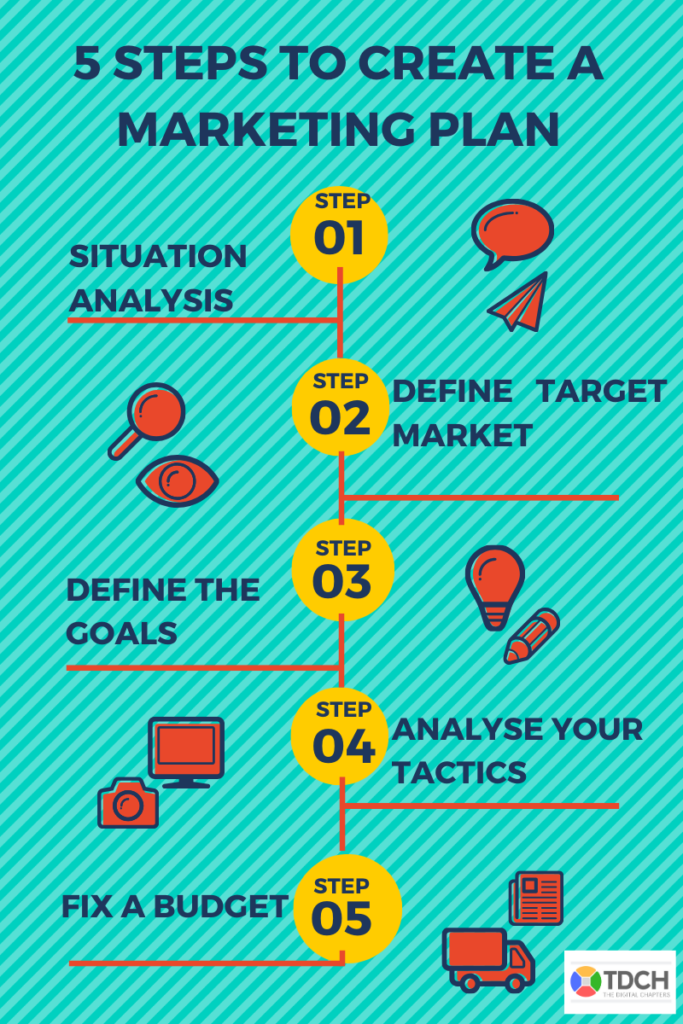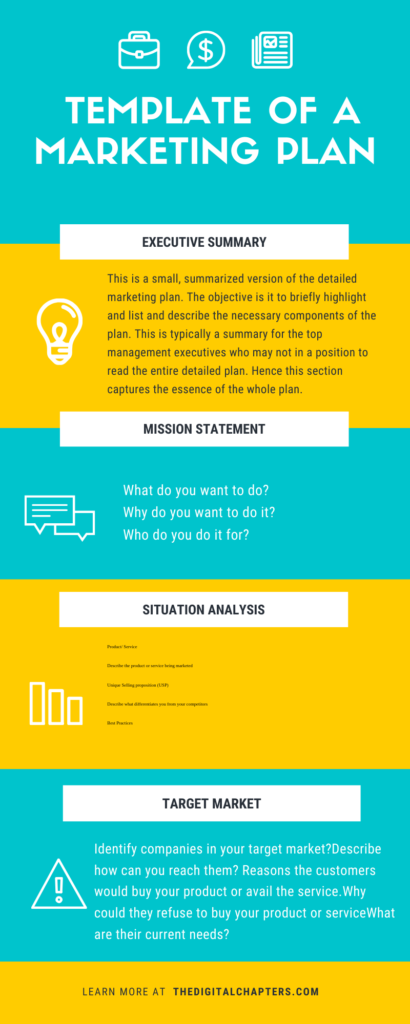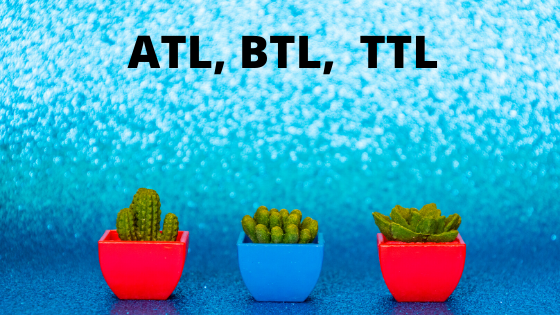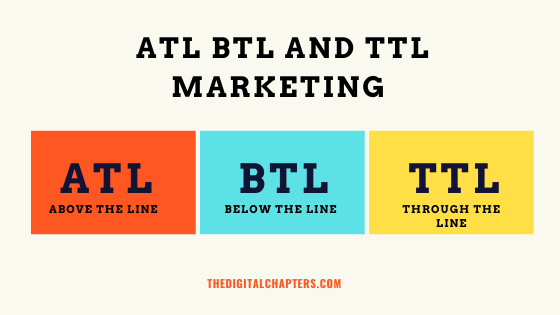Marketing Plan and Marketing Strategy
Marketing is a critical element of any business. Without suitable and sustainable marketing efforts, a majority of the businesses would stare at failure. Here is in this blog I will discuss about Marketing strategy and Marketing Plan. What are some of the best Marketing Plan example?
Benjamin Franklin once correctly mentioned “Failing to plan is planning to fail”. Hence without a marketing plan, you are preparing yourself to fail.
Table of Content
- Marketing plan –Definition and explanation.
- Difference between Marketing Strategy and a marketing plan
- Steps in developing a marketing plan
- Step 1: Carry out a situation analysis
- Step 2: Enumerate and define a focused target market
- Step 3: Define the goals
- Step 4: Analyse your tactics
- Step 5: Fix a budget
- How to structure your marketing plan
- Business Summary
- Business Initiatives
- Target Market
- Market Strategy
- Budget
- Marketing Channels
- Draft Template of a marketing plan
1.Marketing plan –Definition and Explanation
At the heart of the overall business plan lies the marketing plan.
A marketing plan is nothing but a detailed one-stop document that describes the marketing and promotional efforts over a specified time frame.

There could a detailed strategic plan spread over a few years and then an annual marketing plan in order to implement the long term strategic goals.
In order words, a marketing plan is nothing but a detailed road-map to define, implement and track the strategic marketing activities over a given period of time.
While individual marketing teams within a company can have different strategies all of them eventually work towards a common objective.
2. Difference between marketing strategy and marketing plan

Marketing strategy and marketing plan are often used interchangeably. However they are different. The marketing strategy is a description of how a corporation will accomplish a specific goal.
A strategy could include the various marketing content, the market campaigns and the marketing types (ATL, TTL, and TTL) applicable.
Additionally the strategy could specify how the objective will be tracked.
A marketing plan is an aggregation of various marketing strategies.
Simply visualize the marketing plan as an elaborate framework from where the various marketing strategies are generates and this same framework itself helps you connect each of the defined strategy back to the larger marketing goal.
Consider an example, wherein an organization is in the process of launching a brand new Software product and you want so attract customers to this software.
The primary objective of the marketing plan is creating a market for the product you’re selling by describing the product along with drivers that will boost the sales.
They would use various strategies to implement this plan like launching a blog, sharing YouTube videos, writing Twitter feeds amongst others.
Thus in the above example, there is a distinct difference noted between a plan and a strategy.
While the marketing plan is focused on launching the new software and consequently drive sales, the plan would be executed using the various strategies like blogs, YouTube videos and Twitter feeds.
3. 5 Steps to create a marketing plan

Step 1: Carry out a situation analysis
Before detailing a marketing plan, it is imperative to know where you stand and what the current situation you find yourself in is.
Try plot out a strength, weakness, opportunities an threat analysis as a basic first step. In addition assess the current market and where you stand in relation to your competitors.
Try to find out gaps in your competitors’ products that can offer you a competitive advantage.
Step 2: Enumerate and define a focussed target market
Create an ideal buyer image that would buy your company products. Conduct a market research. Identify the proposed target audience in terms of demographics like age, location, income and other criteria. Try and understand what the drivers for your target audience are.
Step 3: Define the goals
Define the marketing goals that must be fulfilled. The defined goals must be specific, measurable, attainable, relevant and time-bound.
For instance, a goal could be to increase the sales by 15% in 6 months. Basis the overall marketing goals, the goals must be specific and attainable.
Step 4: Analyse your tactics
This section of the plan deals with identifying the tactics that will help you achieve your marketing goals along with laying down the marketing channels and the action items to be especially focussed upon.
Step 5: Fix a budget
Prior to implementing any of the ideas one must know the financial resources available at their disposal. For instance your proposal may have television commercial runs.
However if you don’t have the required budget for the same, you may be able to achieve this goal. While deciding on the tactics, one must have a note of the estimated budget and align the tactics accordingly.
4. How to structure your marketing plan
Whether one is into directly selling to consumers (B2C) or it is selling to other businesses (B2B), there is a common underlying structure to make and effective marketing plan.
The structure should normally be arranged in a logical sequence. Below is a basic sequential structural outline.
1. Business Summary
This section is self-explanatory and enumerates your origination details and highlights the mission statement consistent with the business.
In addition the same should include a brief summary of the business as a whole.
Post that same should move on to focus on the marketing aspects and highlight the strengths and weaknesses via SWOT analysis.
2. Business Initiatives
This segment helps arrange the various goals of the marketing department. Specific marketing related projects should be outlined in detail.
Additionally the detailed description of the goals and the ways of tracking those goals must be mentioned.
3. Focus on Target Marketing
Describe the customer you`re selling to, competition analysis and your ideal buyer demographics. The goal is to create a your company`s buyer persona.
This can be carried out through a detailed market search. The buyer persona would be a character depicting your ideal end customer and would have defined attributes in terms of job titles, age, location and other demographics,
4. Market Strategy
This segment used the date enumerated in the target market section to elaborate on ways to tap or capture the said market.
This section details the product, price, place, promotion, people, process, and physical evidence more popularly known as the 7Ps of marketing.
5. Budget
The budget aspect of the marketing plan is not to be confused with the end product`s price.
This section deal with the financial resources available with the marketing team to pursue the marketing objectives highlighted in the plan.
Depending on the overall budget, the company must consider segregating the budget amongst various activities.
For instance, one can segregate the spends basis –Marketing agency hire, Software hire, promotional hire, event organizations.
6. Marketing Channels
The final section of the marketing plan deals with the marketing channels being employed.
The marketing channels are the eventual medium used to pass on your and your company’s message to the end users and spread awareness.
Whether you opt for mass market channels, niche targeted marking channels or a combination of the two is elaborated in this section.
This section also serves to convince the internal stakeholders about the proposed success of your channels.
5. Draft Template of a marketing plan
Company Name: Write Your Company Name Here
Date: Date on this day you are creating it
Executive Summary: This is a small, summarized version of the detailed marketing plan. The objective is it to briefly highlight and list and describe the necessary components of the plan. This is typically a summary for the top management executives who may not in a position to read the entire detailed plan. Hence this section captures the essence of the whole plan.
Mission Statement
- What do you want to do?
- Why do you want to do it?
- Who do you do it for?
Current Situation analysis
- Product/ Service
- Describe the product or service being marketed
- Unique Selling proposition (USP)
- Describe what differentiates you from your competitors
- Best Practices
- Describe your practices and compare it with industry prevalent best practices
- Marketing objectives and performance
- Define objectives and how to achieve them
- Challenges
- Describe the current challenges being faced by your company
- SWOT Analysis
- Competition Analysis
Target Market
- Identify companies in your target market?
- Describe how can you reach them?
- Reasons the customers would buy your product or avail the service.
- Why could they refuse to buy your product or service
- What are their current needs?
Define Pricing Strategies
- Cost Based?
- Competitor Based?
- Skimming Approach?
- Penetration Approach?
- Bundle Pricing Approach?
Distribution Strategy
- Which is the preferred distribution channel?
- Reasons for choosing it over others
- Highlight the costs related to distributing your products or services?
- How does your distribution channel affect your delivery times.
Describe the various available channels
Check the available channels
- Blog Posts
- Word of mouth publicity
- Embedded internet search engine marketing
- Billboard and other display advertisements
- Outdoor events
- Search Engine Optimization
- Content Marketing
- Email Marketing
- Viral Marketing
- Engineering as Marketing
- Business Development
- Sales
- Affiliate Programs
- Existing Platforms
- Trade Shows
- Offline Events
- Speaking Engagements
- Community Building
Select the top 5 traction channels
- Define channel testing methodologies
Budgeting
- Prepare a detailed budgeting template and segregate the budget activity wise








